Many Swedish cities are affected by the ongoing climate change and need to make extensive climate adaptations on urban planning, specially to minimize the impacts of extreme events as heat waves and heavy rainfalls. Research shows that the implementation of green infrastructures (GI) is a smart and cost-effective way to make cities more sustainable, resilient to climate change and pleasant to live in. GI such as parks, urban forests, gardens, trees along streets and plants on roofs and walls can thus – in addition to contributing to biodiversity, recreational opportunities and well-being – be effective measures to lower the temperatures during heat waves and thus increase population’s thermal comfort, diminishing the number of deaths and hospitalizations during such extreme weather events.
GI can also effectively minimize the impacts of heavy rainfalls by increasing the water infiltration in the soil or retain water in appropriate reservoirs, reducing the risk of flooding in the city, and avoid severe impacts on urban infrastructures, economy and people’s life.
Through case studies for Norrköping and Malmö, researchers will examine how different types of GI can increase thermal comfort and limit severe flooding during past and future extreme weather events, having as examples the severe flooding in the summers of 2014 in Malmö and 2023 in Norrköping, and the extremely hot summer of 2018 that affected the whole of Sweden with a prolonged heat wave.
The main goal of the project is to create a high-resolution, multi-layered and scalable urban atlas with user-tailored actionable climate information to support a multi-functional climate-sensitive urban planning. Such tool will provide more preparedness to cities/municipalities for decision making, potentiating the urban resilience, while promoting societal benefits in terms of health, economy and well-being.
Research questions
The main research questions to be addressed by the project are:
- How will heatwaves and heavy rainfalls in the present climate resemble in the future, such as in a world with a +2°C/+3°C warming?
- How well-prepared are modern cities to cope with heatwaves and heavy rainfalls events?
- Can the existing GI adequately address the increasingly frequent and severe extreme events anticipated in the coming decades?
- Which type of GI prove the highest effectiveness in simultaneously mitigating the impacts of extreme events related to both heat stress and flood risk, and what should be their optimal size?
- How can the need for densification be reconciled in a context of climate-sensitive urban planning?
Research methods
- Co-creation activities with stakeholders
- Climate simulations for specific global warming levels of +2°C/+3°C above pre-industrial levels, which provides the impact of the real effect (global warming) rather than the uncertainty of a time-range.
- Event-based dynamical downscaling from global to urban scale, by using a multi-model chain that includes climate, hydrological and hydraulic models
- Calculation of several impact indicators to support the integrated assessment of GI impacts on human thermal comfort and flash flood risk.

Project team
SMHI coordinates and participates in the project, which also involve participants from Lund University and Swedish University of Agricultural Sciences.
Stakeholders:
- Norrköping municipality
- City of Malmö
Project period
January 1, 2024 – December 31, 2026.
Funder
Swedish research council Formas
Project information in Formas project database: Green4Extremes